LASIK – Laser assisted Keratomileusis is a corrective treatment for myopia, hyperopia and astigmatism. It is a painless outpatient procedure with maximum benefit in refractive error correction surgeries and with minimum complication. With LASIK, the eye surgeon reshapes the cornea with the help of microkeratome and excimer laser, so that light rays can focus on retina easily. Excimer laser ablates the ultra-thin layer of tissue using complex computer calculations with a short exposure time resulting in a very fast visual recovery.
AM I A CANDIDATE FOR LASIK ?
LASIK is not for everyone. LASIK is advocated for mainly refractive error correction after 19-20 years, when the refractive error stabilizes. Ideally the patient shouldn’t be pregnant and the eye should be free of any complicating disease. Excimer laser cannot correct presbyopia. It is better to meet the eye surgeon who examines the eye in detail taking corneal thickness in account, discusses the procedure, risks and complications. Corneal thickness, preexisting dryness, the amount of refractive error together determines the outcome of the procedure.
HOW IS LASIK DONE ?
After anesthetizing with topical drops, the patient is seated on a reclining chair. A speculum is placed between the eyelids in order to keep them open and prevent blinking. Suction ring is placed because of which vision temporarily dims and then microkeratome (Automated surgical instrument) is attached to the suction ring. Microkeratome stops at a preset point and a hinged flap is created. Nowadays, the flap can also be created with laser itself. The computerized preprogrammed customized ablation is done and the flap lifted is folded down. The flap adheres on its own in 2-3 minutes and the patient doesn’t have any pain. The patient is examined after 10-15 minutes, given postoperative drops and instructions and allowed to go home.
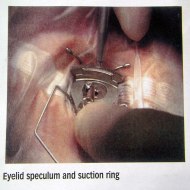
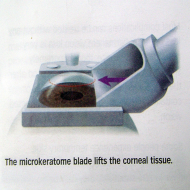
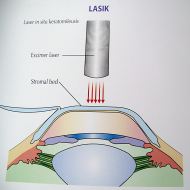
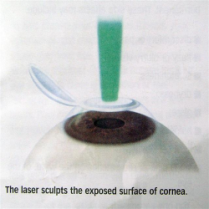
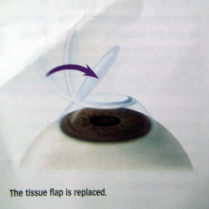 WHAT HAPPENS AFTER SURGERY ?
WHAT HAPPENS AFTER SURGERY ?
Patients are advised to wear protective glasses/goggles. Patients will be able to see clearly within 24 hours. Some patients have burning sensation or scratchy feeling. Eye drops are given to alleviate dryness and help in healing. Swimming is not advised for 3 months preferably.
HOW SAFE IS LASIK ?
LASIK is very safe but like any other surgical procedure it has its risk and complications. Under correction or over correction due to computerized programming error can be improved by further enhancement of surgery. Infection, irregularities in corneal flap, dryness can usually be treated without any loss of permanent vision. Temporary side effects like discomfort, blurry vision, dryness, glare, light sensitivity usually fade within 1 month
ADVANCES IN LASIK SURGERY
Researches have been done in order to improve the technology. Wavefront technology is an additional refining tool used to ensure more safety and quality of vision and it allows finest correction of higher order aberrations which then improves visual outcome to a supernormal vision. Again iris registration technology is a new addition to combat with cyclotorsion of the eye. It now takes less tissue to do the same correction, shortens ablation time and thereby fast visual recovery and so higher refractive error can also be corrected. Femtosecond laser ensures bladeless surgery. The difference is like visualizing old television screen movie to a better resolution aided LCD movie.
bleedless surgery popular know as Femto lasik gives immense benfit in terms of a fast healing with speedier recovery and increase visual benfit.






